Statistical Analysis of Donegal v Tyrone
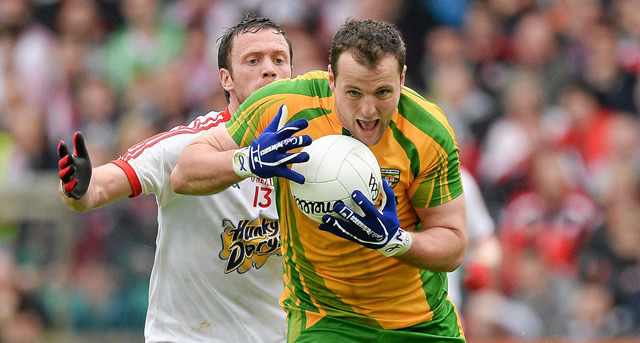
Throughout the 2013 Ulster Senior Championship, Ulster GAA will be compiling a report of the key statistics from each match. The reports will look at a range of factors contributing to game play, including possession breakdown, kick out success, possession to scores ratios and turnover stats.
The purpose of this project is to identify the key differences between team performance, and possibly help pin point where the key differences existed. Ultimately, it is hoped to identify the key area each team needs to address ahead of their next championship outing in 2013.
Ball in Play
As a follow on from the observations made last week in terms of ‘active’ game time, it is notable that the duration of time the ball was in play fell further following this week’s match between Donegal and Tyrone. From a total game time, this week, of 75 minutes 16 seconds, the ball was active for 30 minutes and 7 seconds, a total of 40% (Figure 1). When considered alongside the 44% of active game time between Cavan and Armagh, this may be another strong demonstration of the need to examine our timekeeping and stoppage time procedures still further.
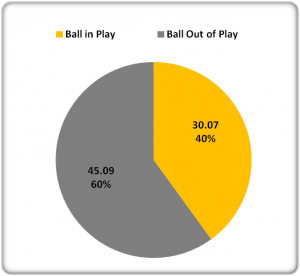
Figure 1: Active Game Time
Possession
Last week demonstrated that dominance in possession did not necessarily translate to successful outcome in terms of the result of the match, and, while this week’s statistics were more evenly balanced, it added further weight to the argument that possession share is irrelevant when deciding on the outcome of the game. In the first half (Figure 2), Donegal had slightly the better of possession, with a 53.3% share, when compared to a 46.7% share for Tyrone. It could be argued that this was evident on the scoreboard with Donegal enjoying a 2 point lead going into half time. Similar to last week, the team leading at half time (Cavan & Donegal) appeared to concede the majority of possession in the second half (Figure 3). Tyrone enjoyed 57.8% possession in the 2nd half of this match, and is very similar to the 59.2% possession secured by Armagh during the 2nd half in last week’s preliminary round fixture. On the balance of the whole match (Figure 4), Tyrone had the superior share of possession, with 52.25%, compared to Donegal’s 47.75% share.
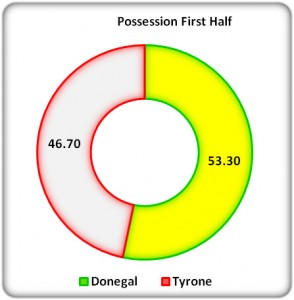
Figure 2: 1st Half Possession
At half time, Donegal had made the most of their marginally superior possession in the first half, and enjoyed a 2 point lead, with a score line of 1-06 to 0-07. However, it is worth noting that despite the lead and superior possession, both teams had taken the same number of scores; 7 each, with Donegal benefiting from a goal.
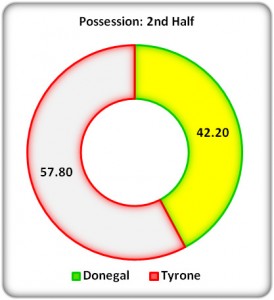
Figure 3: 2nd Half Possession
In the second half, despite having over 15% greater possession than Donegal, Tyrone were outscored by 1-04 to 0-03. This would suggest that Donegal delivered a greater efficiency with possession in the second half.
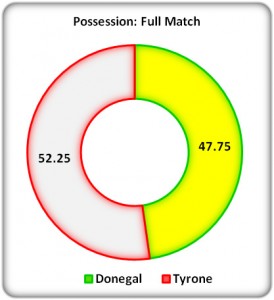
Figure 4: Full Match Possession
Kick Outs
Another long standing belief within the game relates to the importance of securing primary possession from the kick outs. Last week provided a glaring demonstration of how misplaced this belief may be, with Armagh claiming primary possession on 32 occasions, in contrast to Cavan’s 17 occasions. This week’s results also appear to have called into question this belief, with Tyrone winning the majority of primary possessions from kick outs (21), when compared to Donegal (16). Figure 5 provides an overview of the breakdown of kick out possession.
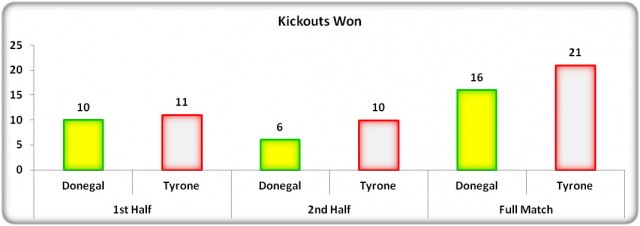
Figure 5: Kick Out Possession
Possession to Scores Ratios
Similar to last week, with Tyrone seemingly superior in possession share, it is important to note why they failed to convert this possession share to an overall victory. The same principle of possession conversion was applied to this game and is outlined below:
1) How many possessions are converted to attacks (pass the opposition 45m line);
2) How many attacks are converted to a shot (goal or point, from set play or open play);
3) How many shots are converted to scores (goals or points).
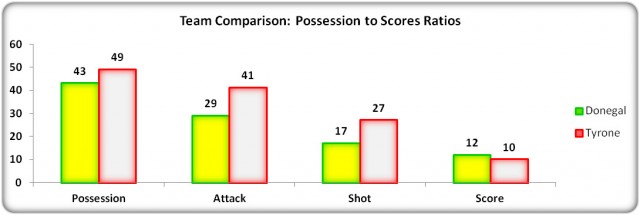
Figure 6: Possession to Scores Ratios
As expected, Tyrone had a superior number of possessions (49, compared to 43), and were also able to convert a much higher percentage of these possessions to attacks: Tyrone – 84%, Donegal 67%. In contrast to Armagh, Tyrone were able to maintain this superiority and convert attacks to scoring chances more effectively than their opponents: Tyrone – 55% of possessions resulted in shots, while Donegal converted 40% of their possessions to shots.
The ultimate difference between Tyrone and Donegal was evident in the final stage, the conversion of shots to scores. Donegal converted 28% of all possessions to scores, while Tyrone could only convert 20%. To date in the USFC 2013 this is the lowest possessions: scores conversion ratio (Cavan – 31%, Donegal – 28%, Armagh – 21%, Tyrone – 20%)
Most striking is the difference in success rate of shots attempted; Donegal – 71%, Tyrone – 37%. As an example of what this means, for Tyrone to convert 10 scores they required 27 attempts. By contrast, for Donegal to convert 10 scores the needed just 14 attempts.
Turnovers
On the basis of figure 6, it is clear that Tyrone turned over a significant portion of possession through unsuccessful shooting. However, Donegal only converted 67% of possessions to attacks, and Tyrone failed to convert 14 attacks to shooting chances. It is important to examine the turnover statistics to assess where each team can improve as they progress to their next match of the 2013 championship.
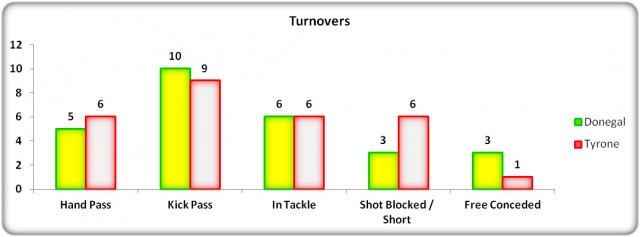
Figure 7: Turnover Statistics
Figure 7 provides an interesting snapshot of the turnover statistics. Interestingly, both teams turned over possession an equal number of times (27). Unsurprisingly, the only sub category of turnover where there was a noticeable difference was in possession turnover through failed shooting; Tyrone – 6, Donegal – 3. This adds further support to the statistic depicted in figure 6, which highlighted Tyrone’s inability to convert shots to scores.
There is also a very noteworthy observation when comparing these turnover statistics to the preliminary match the previous week as shown in figure 8, below. Both Donegal and Tyrone had more turnovers than Cavan and Armagh. When broken down, the most striking statistic was the difference in total number of hand passes resulting in turnover possession. In the Cavan v Armagh match there were only 3 in total in the match, while there were 11 in the Donegal v Tyrone match. This is an interesting statistic, and it may be worth further analysis of the video footage to establish the cause. It could be speculated that a greater defensive intensity during the Donegal v Tyrone match forced these turnovers.
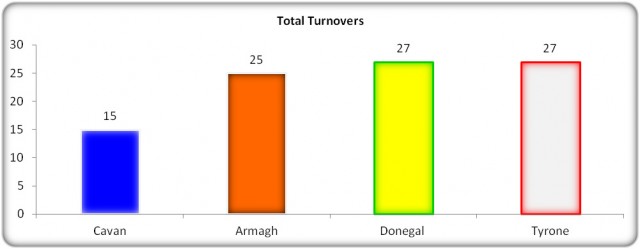
Figure 8: USFC 2013 Turnover Comparison
Summary
In summary, once again this week dominance in possession did not prove to be significant in terms of overall outcome. But, in contrast to last week, Tyrone did convert possession and attacks to shot. Where they did fail was in their success rate from these shots, and this essentially proved to be the difference. Another key finding that unfortunately has to be highlighted is the ‘active’ game time, which was only 40% of the total match time.
Donegal
While Donegal will be happy with the outcome, and on the whole will be satisfied with the possession statistics they will need to focus some attention on their ability to convert possession to attack. To date in the USFC they have the lowest conversion rate in this ratio at just 67% of total possessions. However, a major positive, and worryingly for prospective opponents, is their ability to convert attacks to scores. If they can improve their ability to create attack more often when they gain possession, they appear to be excellent at delivering scores from attacks.
Tyrone
While Tyrone will inevitably be hugely disappointed with the result, the statistics provide comfort in that they created a huge number of scoring opportunities. The issue was evidently in their finishing. There is merit in analysing the shots further through video footage to establish the cause of these failings. It may be a number of factors, including good defending, poor shot selection or poor shot execution, or a combination of all of these factors. Regardless, it is clear that Tyrone need to improve on this shot success rate, and this should form a significant portion of their preparation ahead of their next match.
For further information please contact Kevin McGuigan on kevin.mcguigan.ulster@gaa.ie






